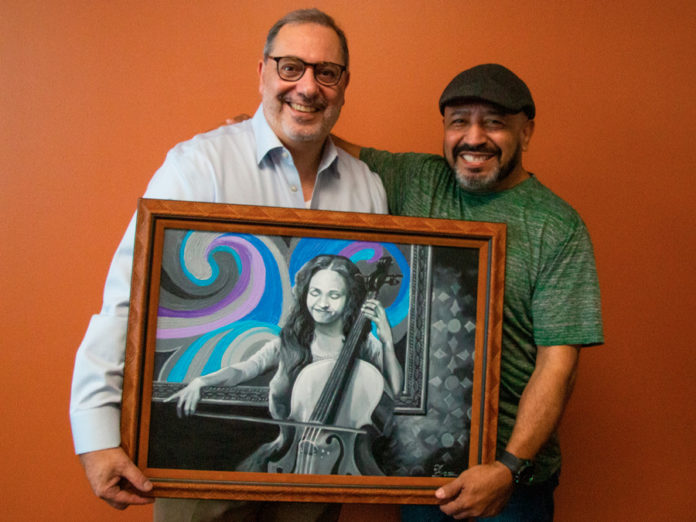Angel LaTorre is a local Philadelphia artist who has been featured in galleries across the country, and whose work is on display in various locations in the city. Impacto sat down with Angel to hear his story of finding his passion and channeling his voice through his art.
Angel, can you share with our readers who you are, where you come from, and what has impacted you the most in becoming the artist you are today?
I was born in Philadelphia in 1960. I was raised by my mother and father, until a point in my life when my grandparents took over. I knew from early age – maybe 6 or 7 years old – that I was inclined toward drawing more than other kids. When I was 8 years old, my mother got me my first sketch book, and I started doodling cartoon figures like Snoopy and Peanuts cartoons. I dabbled here and there with art, but I was never serious about it. I wound up in Cardinal Doughtery high school, and from there I decided to go to the Franklin School of Art.
My passion came when I was at the age of 38. I started with one canvas. I couldn’t afford an easel, so I painted my first painting on top of the heater in my house. From there, I realized I really enjoyed it, and I started crafting my own ideas and studying the works of the masters. Some of my favorites were Renoir and Dali. To this day, as I paint, I am inclined to look at the masters – I love Caravaggio’s realism, and Da Vinci’s sketches; he inspired me to work in sketchbooks. Since then, I started doing art shows at galleries in Atlantic City and other places. There was an art expo at the Apollo, and I was the first Hispanic to show my work there.
My art wasn’t selling as fast as I would have liked, so I got into graphic design, and became a graphic designer for nearly 30 years. I did really well with that, but also continued painting – mostly in oils, acrylics, and watercolors.
It sounds like you didn’t pursue your art in a serious way until you were older. Help us understand the period between high school and when started working on your art more seriously at the age of 38.
My parents weren’t really around – my mother and father separated when I was young. So I didn’t have somebody to continually push me. I was being recognized as a good artist by the nuns and teachers at Cardinal Dougherty, and was encouraged to take more art classes. But when I was a young man in my early twenties, I still didn’t have a lot of interest in art. I loved to draw, but I didn’t feel I could do it every day. After I studied at the Franklin School, I got married and had children. In my late 30s, it finally hit me that I really enjoyed expressing myself through art. Before then, I had been working mostly in watercolors and pencil, with a little acrylic here and there. The oils frightened me somewhat, because they were more complicated. But when I picked up the brush and it landed on the canvas, I saw life come out of it. It made me realize I could express myself, and show people what I can’t relate in words sometimes. I did a lot of work in surrealism and dream works, which allowed me to express something with paint on canvas that I couldn’t put into words.
You were born in Philadelphia, but you do identify as Latino. Can you talk to us about the themes present in your work?
I see myself as not only Latino, but also as a man. When I paint, I try to incorporate both the male and female gaze, and male and female subjects. I think my life and heritage made me very family oriented, because that was something I lacked in my youth. I try to incorporate that into my paintings as a Latino. I also try to incorporate other cultures into my paintings – we have African roots, and I also love Asian works. I try to take viewers to another world in my artwork. I paint sober-minded, but also with my heart.
What would you say to the aspiring artist in our community, younger or older, who are still on their journey?
My motto is “art is the mother of all invention,” and my advice is to pursue that gut feeling that sometimes we are hesitant to express to others. We need to convince ourselves we can do it, instead of trying to convince others that we should be appreciated or accepted. First we have to learn to accept it in ourselves – that we can do it! I think that’s the wall-breaker right there. Grandma Moses started at the age of 80, and her paintings sold when she was 80, and she became a multimillionaire. The thing is to just keep going – there will be signs that you are getting there. I would also tell young people to paint what they feel inside, not just what they see outside. There is something inside of us that we need to get out, and to put on canvas, that is one of a kind, the only one in the whole planet. So artists should just begin to express, begin to research. If an artist doesn’t know their style, they could invent a new style, but they have to study the work of others as well. Eventually, an artist will pick up their own style as they go along. One of the worst things an artist can do is to be anxious to do something quick. We need to have patience with ourselves, and learn our own voices.







